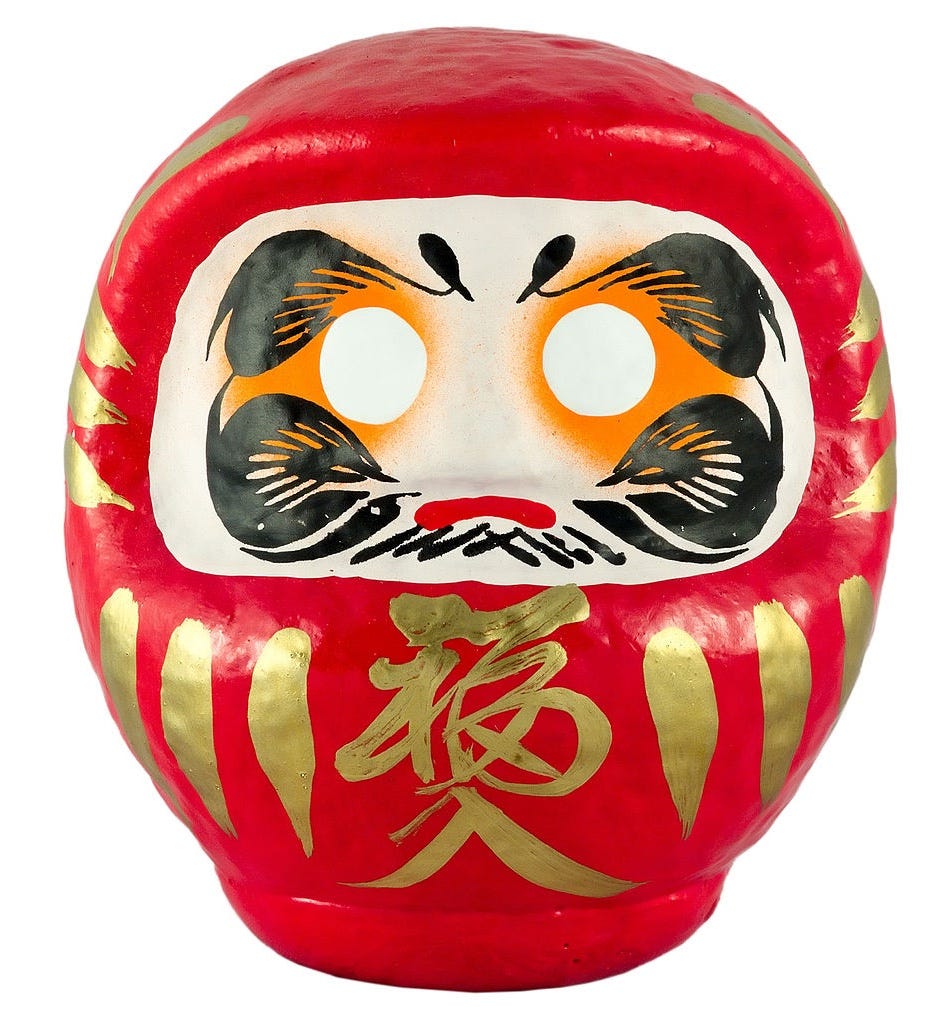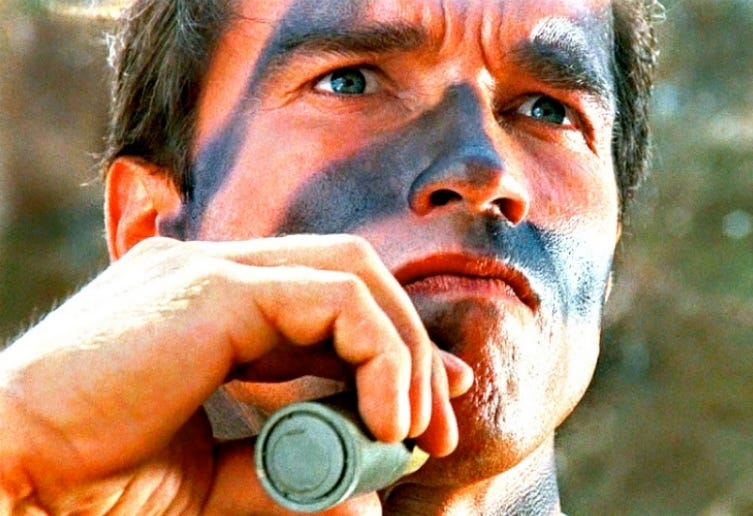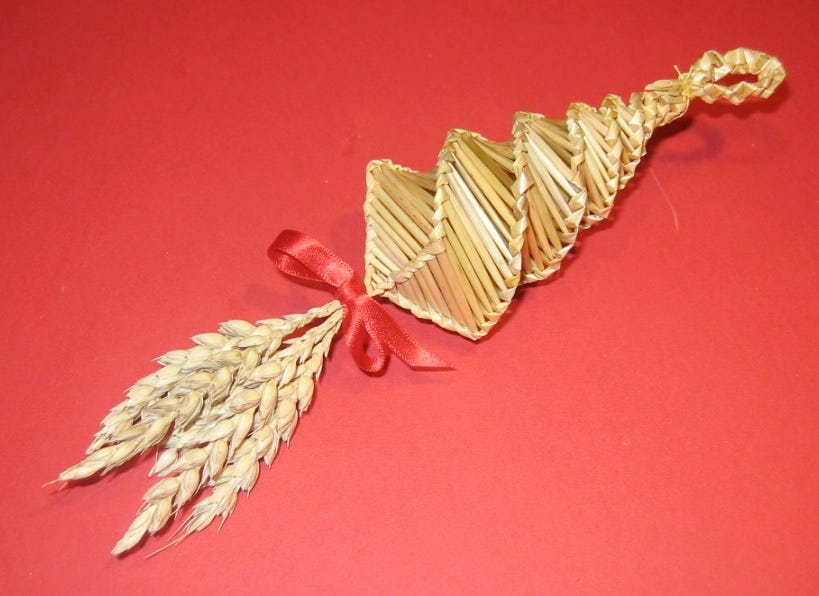I normally post on Tuesdays, as is my wont. I was, though, totally occupied with a very important ritual: I made it my all - - my only priority. I’ve been stewing on this topic a long while; I’m here to tell you that you need good rituals in your life.
When I was at Toyota, we had a Daruma Doll like this. These are a Japanese tradition, and the doll represents the head of Bodhidharma, a Buddhist monk who lived during the 5th and 6th centuries. He’s credited with bringing Zen to China.
When you buy a new one, the eyes are empty and white, like above. On its chest you see 福入 (fuku-iri), which translates as "let luck in". The doll is a talisman, to bring good luck. We were launching a new production line; and, per tradition, we colored in the left eye with black ink when we began. Every day, as we progressed, we saw the one black eye - - and the void in the other, reminding us of our goal. When we successfully launched, we filled in the right eye.
WEEBLES WOBBLE BUT THEY DON’T FALL DOWN
Darumas are usually made of papier-mâché, with a hollow body and weight at the bottom, enabling “okiagari”, in Japanese, to get up (oki) and arise (agari). The doll will always return to an upright position when tilted over, symbolizing the ability to have success, overcome adversity, and recover from misfortune. We Westerners had our Daruma too. While I’m not sure if the Daruma Doll was the inspiration for the 1971 Hasbro Romper Room toy, the egg-shaped roly-poly Weeble would stand back up when pushed over in any direction.
The ritual bonds the team, fosters a sense of belonging, and boosts morale. Cultivate rituals in your own personal projects and those in your organization. Mark the milestones. Celebrate.
Do you have a ritual you perform for a project? Do you have a favorite talisman for good luck? Let us know in the comments.
A GOOD RITUAL NEED NOT BE “PRACTICAL”
I am “Semper Doctrina” - - I am, from the Latin, “always learning”. Recently, I have been learning a lot in the area of “strategy of conflict”.
The recent conflicts in Eastern Europe and the Middle East have forced us to throw out the old manuals, the old doctrines. What we call “big arrow” battles, enabled by maneuvering large amounts of manpower and equipment, might be over, for good, impossible to perform in the new era of constant, overhead surveillance by satelites, aircraft, and drones.
Instead, we see warfare - - even by nation states - - that resemembes the fast, in-and-out, planned chaos of guerrila warfare. It is truly a new kind of hell for the men and women on the ground, being constantly visible to non-human eyes, sensors viewing you in black-and-white, in color, in night vision, and in heat signature (thermal).
MORALE IS THE REASON TO (STILL) PAINT YOUR FACE
While still in the “Soldier Survivability” project phase - - they need a Daruma! - - the military is working on a new face paint to reduce visibilty in the “visible and near-infrared regions of the electromagnetic spectrum", as well as to provide some protection against thermal imagers and insects. I’m hopeful, but I doubt it is going to have a measurable impact on the soldier’s visibility. I want the “war paint” on for a better reason - - for morale.
It is a ritual. It is an ancient ritual, performed throughout history, by a countless multitude of hunters and warriors. The ritual steels the mind; it marks, outwardly, a change in internal state. It is a mental armor of a sort.
Have you seen the movie, “Trading Places”, with Dan Aykroyd and Eddie Murphy? There is a nice scene, near the end, where the two men are preparing for their momentous final battle - - on a Wall Street Trading floor. Here, the “face paint” is not greasy, camoflage makeup, it is instead pressed woolen suits, mirror-polished leather shoes, and stiff, starched cotton shirts. In an earlier post, I refer to my own “Superman shirt”.
Foster ritual armor in your personal life. Foster it in your organization.
Do you have your own form of mental or spiritual armor? Share your story.
GROUP RITUALS ARE GROUP PRAYERS
My last example is the “corn dolly”, an old, English tradition where a village would take the last standing stalk of corn or grain at harvest and fashion a trophy from it. They were typically of local design, as is this example, the “Yorkshire Spiral”.
It was believed that the spirit of the corn would leave the field when it was cut down for harvest. In the trophy fashioned from the last stalk, the spirit could be kept safe until the next planting, at which time the trophy would be sewn into the soil. The corn dolly reminded everyone of the necessity of fertility, in their crops, in their animals, and in their community members. The corn dolly was a community prayer for the next harvest, that it be a good harvest, that it enables the community to survive.
The ritual bonds the community, highlights the interdependent nature of its elements, and aligns everyone to work together for its continuance.
You see, I could go on and on with examples. Perhaps, at one point, a given ritual had a real, practical purpose - - maybe the primal, mud-faced hunter was, in fact, invisible to his quarry. But this does not determine the value of the ritual: The value of a ritual is not limited to its practical value. The value in ritual is mainly in the ways it ties individuals and groups together, connecting them through the past and in the present. This is why we sing “Happy Birthday” to our loved ones. This is why we say “ciao” - - literally, “I’m your slave.” - - as a warm hello or goodbye.
Rededicate yourself to ritual, in your own life, in your family, and in your organization. Rekindle those rituals that you have inherited; make new ones!







